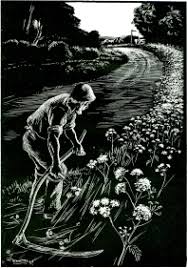This third post about this piece looks at how fragile some materials are. I was fascinated by how parts of the gut are lifted out of the body during open surgery to give the surgeon better access to the mending site beneath. The living structure is cared for whilst out in the open and still functions despite what is going on around, in fact it moves.
This led to some interesting discussions with surgeons as to the nature of the tissues involved and I began to understand the similarities between these and certain fabrics that I know. One of the most extraordinary is connective tissue and the mysentery. This tissue type has more poetry about it than any other as it is changeable and elusive and somewhat mysterious. It webs its' way through the body and reveals itself under a microscope as dewy, fibrous, filmy and like organza.
Throughout this piece of work I have represented it in four ways;as clingfilm around the 'spine', as silver lurex stitches between layers of 'skin', as wide organza ribbon weaving through the 'muscle' and as layered organza in the gut. This last one is featured here and is the one where I took the most artistic liberty with the form!
My elastic band lucet braid gut was tested and approved by a colorectal surgeon and I added in different thicknesses of braid as directed. There are also areas of damage to it which can be 'repaired'. But then I felt that it should sit in a bag as it does when it comes 'out' for an operation and so I used an idea from a screen I made some years ago. Layered organza was finely stitched in patterns and then cut away between the stitches.Some areas were left complete and some are cut away and very fragile. Betweeen these are more unseen areas of 'damage'.
To complete the surface I added scraps of organza as strange little florets because the cut edges catch on all around them, rather like the regrowing fascia can in the gut after an operation.
The final touch was to put a drawstring around the edge of the bag and sit the 'guts' inside.They then sit atop the 'vascular' layer of the 'body' and have to be carefully extricated every time we demonstrate it.
The organza has interesting qualities in this its 'organdy' version, that is to say in cotton. Despite its fine weave it holds shape well and can be used for very sculptural work. As it is transparent it allows no faults or hiding of mistakes. It is both strong and very fragile, mostly when cut into smaller pieces where it starts to disintegrate.By layering it you can create what I have been told are perineal spaces within the work!
The final poetic mysenteric bag is shown here.





























